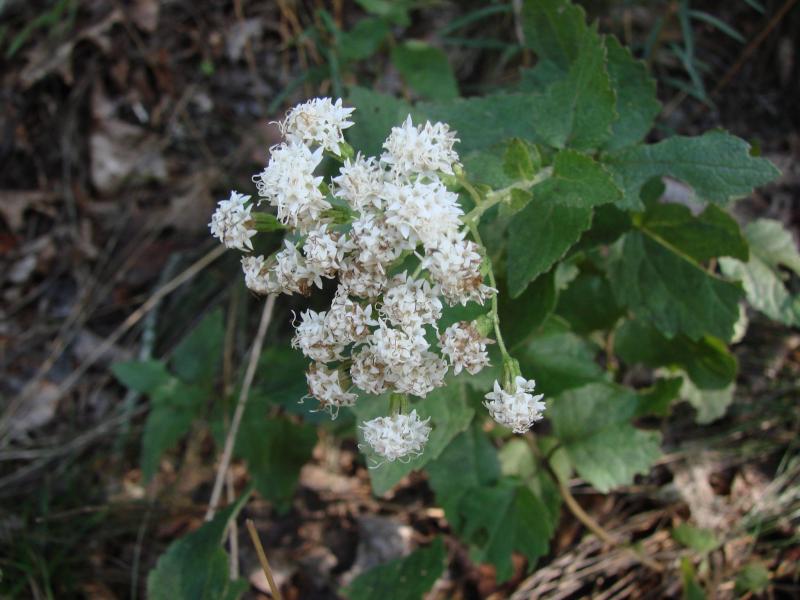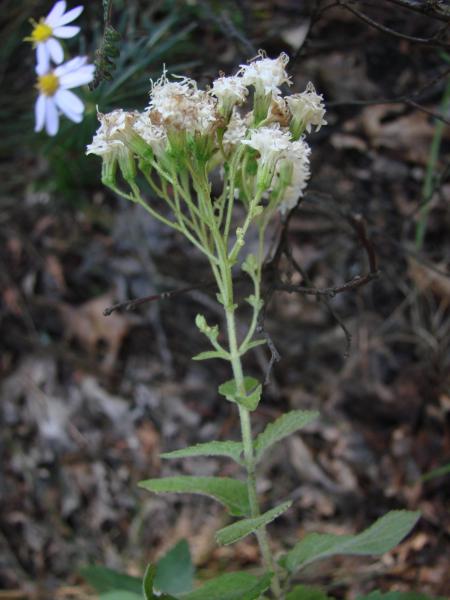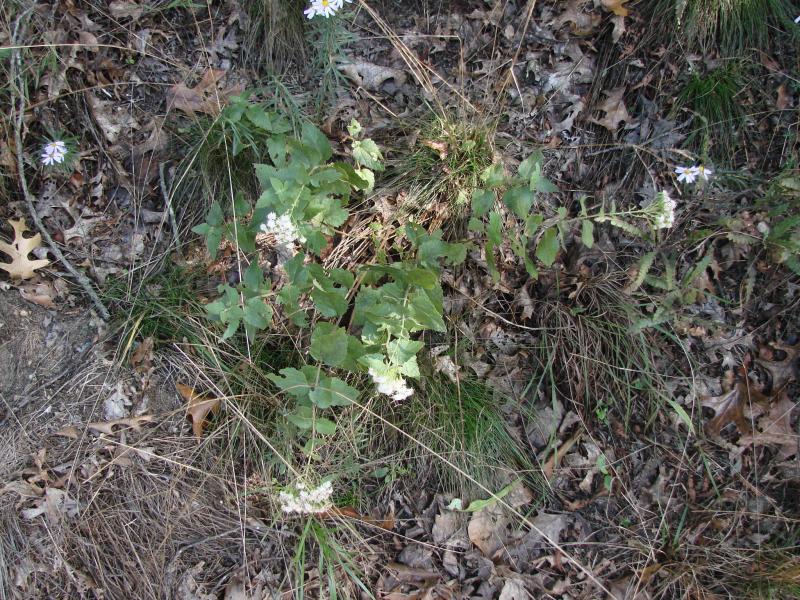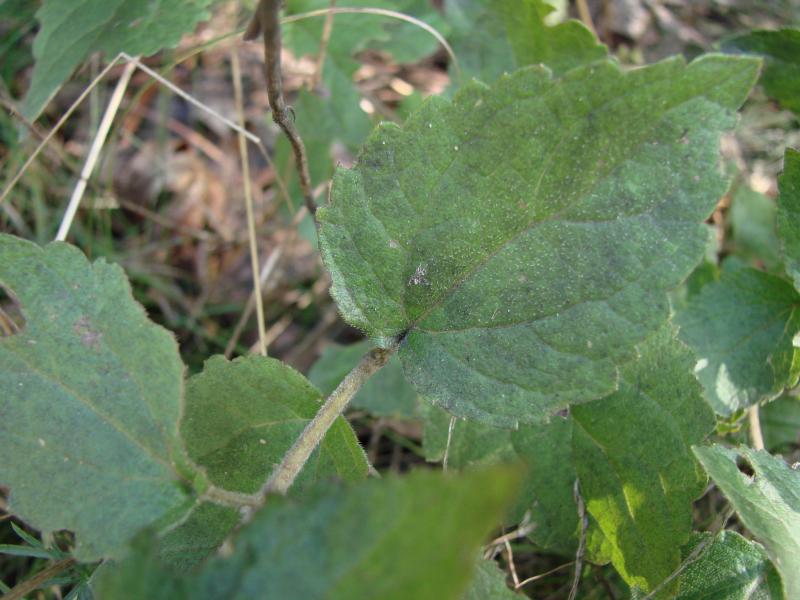Small White Snakeroot
Ageratina aromatica var. aromatica None
- Class
- Dicotyledoneae (Dicots)
- Family
- Asteraceae (Aster Family)
- State Protection
- Endangered
Listed as Endangered by New York State: in imminent danger of extirpation in New York. For animals, taking, importation, transportation, or possession is prohibited, except under license or permit. For plants, removal or damage without the consent of the landowner is prohibited.
- Federal Protection
- Not Listed
- State Conservation Status Rank
- S1
Critically Imperiled in New York - Especially vulnerable to disappearing from New York due to extreme rarity or other factors; typically 5 or fewer populations or locations in New York, very few individuals, very restricted range, very few remaining acres (or miles of stream), and/or very steep declines.
- Global Conservation Status Rank
- G5T5
Secure globally - Both the species as a whole and the subspecies/variety are common in the world; widespread and abundant (but may be rare in some parts of its range).
Summary
Did you know?
Even though the species name is aromatica, the leaves and flowers do not have much of a fragrance. The genus name comes from the Greek word "Agera" which means not growing old and refers to the long-lasting flowers and leaves (Tenaglia 2007).
State Ranking Justification
There are four existing occurrences but two of them have not been found again after one survey. There are 29 historical occurrences beginning in 1868 on Staten Island. Almost all of the historical collections occur between 1868 and 1929 with none later than 1936. Plants were rediscovered in 1991.
Short-term Trends
Short term trends are unknown. Two of the four existing occurrences could not be found a second time but they may still be present.
Long-term Trends
There has been a large decline in populations from historical times. There were many occurrences in the late 1800s and early 1900s but today only a small number of populations can be found.
Conservation and Management
Threats
All of the occurrences occur in areas with a lot of human activity and natural succession that might affect the plants.
Conservation Strategies and Management Practices
This species grows in early successional habitats and management strategies should include methods to prevent natural succession from eliminating plants while preventing direct impacts from human activity such as improper road and trail maintenance.
Research Needs
Research is needed to assess the best way to manage for protection of this species.
Habitat
Habitat
More information is needed on the habitat preferences of Small White Snakeroot in New York. It has been found growing on mowed roadsides, old railroad corridors that are now trails, and in dry woods (New York Natural Heritage Program 2012). Sandy soils, burned pinelands, turkey oak sand ridges, pine-oak and oak-hickory upland woods, old fields, roadsides, fencerows, moist sites (FNA 2006). Dry woods, especially in sandy soil (Gleason and Cronquist 2001).
Associated Ecological Communities
- Coastal oak-heath forest*
(guide)
A low diversity, large patch to matrix, hardwood forest that typically occurs on dry, well-drained, sandy soils of glacial outwash plains or moraines of the Atlantic Coastal Plain. The forest is usually codominated by two or more species of scarlet oak, white oak, and black oak.
- Coastal oak-hickory forest
(guide)
A hardwood forest with oaks and hickories codominant that occurs in dry, well-drained, loamy sand of knolls, upper slopes, or south-facing slopes of glacial moraines of the Atlantic Coastal Plain.
- Maritime pitch pine dune woodland*
(guide)
A maritime woodland that occurs on stabilized parabolic dunes. The substrate is wind and wave deposited sand that is usually excessively well-drained and nutrient poor. The community is subject to high winds, sand-blasting, salt spray, and shifting substrate.
- Maritime post oak forest*
(guide)
An oak-dominated forest that borders salt marshes or occurs on exposed bluffs and sand spits within about 200 meters of the seacoast. The trees may be somewhat stunted and flat-topped from pruning by salt spray and wind exposure. The forest is usually dominated by two or more species of oaks, including post oak, black oak, scarlet oak, and white oak.
- Pine barrens shrub swamp*
(guide)
A shrub-dominated wetland that occurs in shallow depressions in the coastal plain, often as the transition zone between a coastal plain pond shore and either pitch pine-scrub oak barrens or pitch pine-oak forest.
- Pitch pine-scrub oak barrens*
(guide)
A shrub-savanna community that occurs on well-drained, sandy soils that have developed on sand dunes, glacial till, and outwash plains.
* probable association but not confirmed.
Range
New York State Distribution
This species is currently known only from Suffolk County on eastern Long island, but it was historically known west to New York City and Staten Island with a report from Westchester County.
Global Distribution
Ageratina aromatica var. aromatica occurs from eastern Massachusetts and southeastern New York south to Florida and west to a line from Ohio to Louisiana.
Identification Comments
General Description
Small White Snakeroot was previously included in the genus Eupatorium. It is an erect perennial herb from about 12 to 28 inches tall. It has opposite, triangular leaves on short petioles, with crenate (wavy) to dentate (toothed) margins. The flower heads occur in clusters of 5 to 10, and have discoid flowers with white corollas about 0.2 inches long. The stems and petioles are covered with fine hairs.
Best Life Stage for Proper Identification
Small White Snakeroot is best identified in flower.
Similar Species
Ageratina altissima (the most similar species) is taller (up to 60 inches), its flowering heads have more flowers (10 to 34), and has longer petioles (up to 1/3 the length of the leaf blade) than Ageratina aromatica var. aromatica. A. altissima also has shorter corollas (about 1/8 to 3/16 of an inch) than those of A. aromatica var. aromatica (3/16 to 1/4 of an inch). Variety aromatica is the only variety of A. ageratina found in New York. Variety incisa is found in Virginia and Florida.
Best Time to See
Surveys for small white snakeroot should be conducted in August or September.
- Flowering
- Fruiting
The time of year you would expect to find Small White Snakeroot flowering and fruiting in New York.
Small White Snakeroot Images
Taxonomy
Small White Snakeroot
Ageratina aromatica var. aromatica None
- Kingdom Plantae
- Phylum Anthophyta
- Class Dicotyledoneae
(Dicots)
- Order Asterales
- Family Asteraceae (Aster Family)
- Order Asterales
- Class Dicotyledoneae
(Dicots)
- Phylum Anthophyta
Synonyms
- Eupatorium aromaticum L.
Comments on the Classification
All of our Ageratina aromatica are variety aromatica.
Additional Resources
Best Identification Reference
Flora of North America Editorial Committee. 2006. Flora of North America North of Mexico. Vol. 21. Magnoliophyta: Asteridae, Part 8: Asteraceae, part 3. Oxford Univ. Press, New York. xxii + 616 pp.
Other References
Craine, S. I. 2003. Ageratina aromatica (L.) Spach (Lesser Snakeroot) Conservation and Research Plan for New England. New England Wild Flower Society, Framingham, Massachusetts, USA.
Fernald, M. L. 1950. Gray's manual of botany. 8th edition. Corrected printing (1970). D. Van Nostrand Company, New York. 1632 pp.
Gleason, Henry A. and A. Cronquist. 1991. Manual of Vascular Plants of Northeastern United States and Adjacent Canada. The New York Botanical Garden, Bronx, New York. 910 pp.
Holmgren, Noel. 1998. The Illustrated Companion to Gleason and Cronquist's Manual. Illustrations of the Vascular Plants of Northeastern United States and Adjacent Canada. The New York Botanical Garden, Bronx, New York.
Mitchell, Richard S. 1986. A checklist of New York State plants. Bulletin No. 458. New York State Museum. 272 pp.
Mitchell, Richard S. and Gordon C. Tucker. 1997. Revised Checklist of New York State Plants. Contributions to a Flora of New York State. Checklist IV. Bulletin No. 490. New York State Museum. Albany, NY. 400 pp.
New York Natural Heritage Program. 2024. New York Natural Heritage Program Databases. Albany, NY.
Weldy, T. and D. Werier. 2010. New York flora atlas. [S.M. Landry, K.N. Campbell, and L.D. Mabe (original application development), Florida Center for Community Design and Research http://www.fccdr.usf.edu/. University of South Florida http://www.usf.edu/]. New York Flora Association http://newyork.plantatlas.usf.edu/, Albany, New York
Links
About This Guide
This guide was authored by: Stephen M. Young
Information for this guide was last updated on: September 6, 2012
Please cite this page as:
New York Natural Heritage Program. 2024.
Online Conservation Guide for
Ageratina aromatica var. aromatica.
Available from: https://guides.nynhp.org/small-white-snakeroot/.
Accessed July 26, 2024.



